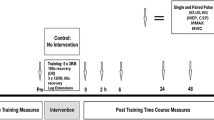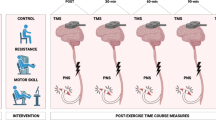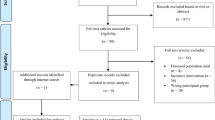Abstract
While it is known that resistance training causes changes in the central nervous system (CNS) in the initial stages of training, there have been few studies of cumulative or sustained neural adaptation to resistance training beyond the initial periods. To further investigate this we compared the electromyographic (EMG) response to transcranial magnetic stimulation (TMS) during voluntary contractions of ten subjects who have been training for more than 2 years, resistance-training (RT) group, and ten subjects that have never participated in resistance training (NT). The active motor threshold for biceps brachii was obtained during voluntary elbow flexion at 10% of maximal voluntary contraction (MVC). TMS was also delivered at 100% of the maximal stimulator output while the participants exerted forces ranging from 10 to 90% of MVC. Evoked force, motor-evoked potential (MEP) amplitude and latency from biceps brachii was recorded for each condition to explore changes in corticospinal excitability. The evoked force was significantly lower in the RT group in comparison with the NT group between 30 and 70% of MVC intensity (P<0.05). At 90% of MVC, nine subjects from the RT group showed an absence in the evoked force while this occurred in only five subjects from the NT group. The MEP amplitude and latency changed significantly (P<0.001) with increasing levels of contraction, without significant difference between groups. These results indicate that changes in the CNS are sustained in the log-term practices of resistance training and permit a higher voluntary activation at several intensities of the MVC.





Similar content being viewed by others
References
Aagaard P, Simonen EB, Andersen JL, Magnusson P, Dyhre-Poulsen P (2002) Neural adaptation to resistance training: changes in evoked V-wave and H-reflex responses. J Appl Physiol 92:2309–2318
Belanger AY, McComas AJ (1981) Extent of motor unit activation during effort. J Appl Physiol 51:1131–1135
Bellemare F, Woods JJ, Johansson R, Bigland-Ritchie B (1983) Motor-unit discharge rates in maximal voluntary contractions of three human muscles. J Neurophysiol 50:1380–1392
Buchanan TS, Rovai GP, Rymer WZ (1989) Strategies for muscle activation during isometric torque generation at the human elbow. J Neurophysiol 62:1201–1212
Buchanan TS, Almdale DP, Lewis JL, Rymer WZ (1986) Characteristics of synergic relations during isometric contractions of human elbow muscles. J Neurophysiol 56:1225–1241
Calancie B, Nordin M, Wallin U, Hagbarth KE (1987) Motor-unit responses in human wrist flexor and extensor muscles to transcranial cortical stimuli. J Neurophysiol 58:1168–1185
Carolan B, Carafelli E (1992) Adaptations in coactivation isometric resistance training. J Appl Physiol 73:911–917
Carroll TJ, Riek S, Carson RG (2002) The sites of neural adaptation induced by resistance training in humans. J Physiol 544:641–652
Danion F, Latash ML, Li S (2003) Finger interactions studied with transcranial magnetic stimulation during multi-finger force production tasks. Clin Neurophysiol 114:1445–1455
Day BL, Rothwell JC, Thompson PD, Dick JP, Cowan JM, Berardelli A, et al (1987) Motor cortex stimulation in intact man. 2. Multiple descending volleys. Brain 110:1191–1209
De Luca CJ, LeFever RS, McCue MP, Xenakis AP (1982) Behaviour of human motor units in different muscles during linearly varying contractions. J Physiol 329:113–128
De Serres SJ, Enoka RM (1998) Older adults can maximally activate the biceps brachii muscle by voluntary command. J Appl Physiol 84:284–291
Enoka RM (1997) Neural adaptations with chronic physical activity. J Biomech 30:447–455
Enoka RM, Fuglevand AJ (2001) Motor unit physiology: some unresolved issues. Muscle Nerve 24:4–17
Gandevia SC, Allen GM, McKenzie DK (1995) Central fatigue. Critical issues, quantification and practical implications. Adv Exp Med Biol 384:281–294
Garland SJ, Griffin L (1999) Motor unit double discharges: statistical anomaly or functional entity? Can J Appl Physiol 24:113–130
Hakkinen K, Komi PV (1983) Electromyographic changes during strength training and detraining. Med Sci Sport Exerc 15:455–460
Jensen JL, Marstrand PC, Nielsen JB (2005) Motor skill training and strength training are associated with different plastic changes in the central nervous system. J Appl Physiol 99:1558–1568
Kiers L, Clouston P, Chiappa KH, Cros D (1995) Assessment of cortical motor output: compound muscle action potential versus twitch force recording. Electroencephalogr Clin Neurophysiol 97:131–139
Kukulka CG, Clamann HP (1981) Comparison of the recruitment and discharge properties of motor units in human brachial biceps and adductor pollicis during isometric contractions. Brain Res 19:45–55
Macefield VG, Fuglevand AJ, Bigland-Ritchie B (1996) Contractile properties of single motor units in human toe extensors assessed by intraneural motor axon stimulation. J Neurophysiol 75:2509–2519
Magistris MR, Rosler KM, Truffert A, Myers JP (1998) Transcranial stimulation excites virtually all motoneurons supplying the target muscle. A demonstration and a method improving the study of motor evoked potentials. Brain 121:437–450
Merton PA (1954) Voluntary strength and fatigue. J Physiol 123:553–564
Pascual-Leone A, Grafman J, Hallett M (1994) Modulation of cortical motor output maps during development of implicit and explicit knowledge. Science 263:1287–1289
Pascual-Leone A, Nguyet D, Cohen LG, Brasil-Neto JP, Cammarota A, Hallett M (1995) Modulation of muscle responses evoked by transcranial magnetic stimulation during the acquisition of new fine motor skills. J Neurophysiol 74:1037–1045
Person RS, Kudina LP (1972) Discharge frequency and discharge pattern of human motor units during voluntary contraction of muscle. Electroencephalogr Clin Neurophysiol 32:471–483
Reid A, Chiappa KH, Cors D (2002) Motor threshold, facilitation and the silent period in cortical magnetic stimulation. In: Pascual-Leone A, Davey NJ, Rothwell JC, Wassermann EM, Puri BK (eds) Handbook of transcranial magnetic stimulation. Arnold, London, pp 97–111
Rosenthal J, Waller HJ, Amassian VE (1967) An analysis of the activation of motor cortical neurons by surface stimulation. J Neurophysiol 30:844–858
Rothwell JC, Day BL, Thompson PD, Dick JP, Marsden CD (1987) Some experiences of techniques for stimulation of the human cerebral motor cortex through the scalp. Neurosurgery 20:156–163
Rutherford OM, Jones DA (1986) The role of learning and coordination in strength training. Eur J Appl Physiol 55:100–105
Sale DG (1988) Neural adaptation to resistance training. Med Sci Sport Exerc 20:S135–S145
Taylor JL, Allen GM, Butler JE, Gandevia SC (1997) Effect of contraction strength on responses in biceps brachii and adductor pollicis to transcranial magnetic stimulation. Exp Brain Res 117:472–478
Thomas CK, Johansson RS, Bigland-Ritchie B (1999) Pattern of pulses that maximize force output from single human thenar motor units. J Neurophysiol 82:3188–3195
Todd G, Taylor JL, Gandevia SC (2003) Measurement of voluntary activation of fresh and fatigued human muscles using transcranial magnetic stimulation. J Physiol 551:661–671
Van Cutsem M, Duchateau J, Hainaut K (1998) Changes in single motor unit behaviour contribute to the increase in contraction speed after dynamic training in humans. J Physiol 513:295–305
Yue GH, Ranganathan VK, Siemionow V, Liu JZ, Sahgal V (2000) Evidence of inability to fully activate human limb muscle. Muscle Nerve 23:376–384
Zajac FE, Young JL (1980) Properties of stimulus trains producing maximum tension-time area per pulse from single motor units in medial gastrocnemiu muscle of the cat. J Neurophysiol 43:1206–1220
Zehr EP, Sale DG (1994) Ballistic movement: muscle activation and neuromuscular adaptation. Can J Appl Physiol 19:363–378
Ziemann U, Rothwell JC (2000) I-waves in motor cortex. J Clin Neurophysiol 17:397–405
Acknowledgements
This work was supported by a Xunta de Galicia Grant (PGIDIT02BTF13701PR). We wish to thank Prof. John Rothwell for his suggestions and Noa Fogelson for the revision of the manuscript.
Author information
Authors and Affiliations
Corresponding author
Rights and permissions
About this article
Cite this article
Fernandez del Olmo, M., Reimunde, P., Viana, O. et al. Chronic neural adaptation induced by long-term resistance training in humans. Eur J Appl Physiol 96, 722–728 (2006). https://doi.org/10.1007/s00421-006-0153-5
Accepted:
Published:
Issue Date:
DOI: https://doi.org/10.1007/s00421-006-0153-5




